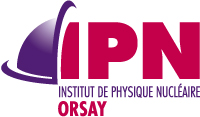Mapping the Big Island of Deformation around N=20 and 28
Cartographie du grand îlot de déformation autour de N = 20 et 28
Résumé
Magic numbers of nucleons, which appear as large energy gaps in the spherical nuclear shell model, have been known to erode and emerge in asymmetric nuclear systems. The evolution of this behaviour is studied in two regions at, and near, magic neutron numbers N=20 and N=28 in neutron-rich neon and aluminium nuclei. Collectivity and excited state structure is studied through in-beam gamma-ray spectroscopy of one- and two-nucleon knockout reactions, and inelastic scattering. Experiments were carried out at the RIKEN Nishina Center in Tokyo, Japan. Prompt gamma-rays were observed in the DALI2 detector and the nuclear structure of neutron-rich neon and aluminium isotopes were deduced. In addition, inclusive and exclusive cross sections to bound states from one- and two-proton knockout reactions, in combination with shell model calculations and reaction theory, extends systematic trends in the region. The two neutron-rich territories of N=20 and N=28 have been discussed as an extended island of deformation, joined-up through the magnesium isotopic chain. These observations enhance the mapping of this region and contribute to understanding the driving forces behind its formation.
Les nombres magiques de nucléons, qui se manifestent par de grandes écarts en énergie dans le modèle en couches sphériques, s'érodent et émergent dans les systèmes nucléaires asymétriques. L'évolution de ce comportement est étudiée dans deux régions sur, et près, des nombres magiques de neutrons N = 20 et N = 28 dans les isotopes de néon et d'aluminium riches en neutrons. La collectivité et la structure des états excités est étudiée par la spectroscopie gamma en-ligne des réactions de knock-out d'un et deux nucléons, et la diffusion inélastique. Les expériences ont eu lieu au RIKEN Nishina Center à Tokyo, Japon. Les rayons gamma prompts ont étés observées dans le détecteur DALI2 et la structure nucléaire des isotopes de néon et d'aluminium riches en neutrons ont étés déduites. Entre outre, les sections-efficaces inclusives et exclusives des états liés induites par le knockout d'un ou deux protons, en combinaison avec les calculs du modèle en couche et la théorie réactionnelle, élargissent les tendances systématiques de la région. Les deux régions riches en neutrons à N = 20 et N = 28 ont été discutés dans les contexte d'un grand îlot de déformation réuni par la chaîne isotopique du magnésium. Ces observations élargissent la cartographie de cette région et contribue à la compréhension des forces motrices derrière sa formation.
Origine : Version validée par le jury (STAR)


